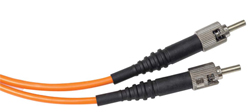A Look At Fiber Optic Connectors And Their Applications
Since the first fiber optic connectors in the 1970s, many different designs have come and gone, but a number of connector types have evolved and withstood the test of time to become standard in the fiber optics industry for all applications. These types include: ST, FC, SC, and LC. Other application- specific connector designs include expanded beam, fiber ribbon array, and hermaphroditic styles.
Optical connectors provide the mechanical connection between different fiber cables or patch cords to active devices in transmitters and receivers. The ideal optical connector holds the fibers in perfect alignment, in three axes. This alignment must be maintained over hundreds or thousands of connect-disconnect cycles to provide stable, repeatable, low-attenuation characteristics. Some of the key features of optical connectors include:
Yield repeatable, low loss optical connections with low reflectance
Physically rugged, large enough to handle but small enough for running through ducts, etc.
Good mechanical strength and strain relief
Easy to clean
Repairable in the field
Cost effective
Compatible with standard fibers and patch cords
The ST optical connector, like this one by Gefen, has become the de-facto standard in the security market and is commonly used in the AV market on such products as HDSDI, RGB/DVI, and others. which provides the precise alignment and centering of the optical fiber. Ferrules can be made of ceramic, metal, glass, or plastic. Ceramic ferrules with metal inserts are most widely used, providing the best tolerances and durability.
The body of the plug holds the ferrule, the coupling mechanism and the boot. The body contains either a threaded, push-pull, or bayonet coupling mechanism that mechanically holds the plug with the mating receptacle and also provides a keying function that allows the connector to mate in only one position. Strain relief of the cable is usually by a crimp sleeve which firmly secures the aramid fibers in the cable to the plug body. Strain relief can also be provided by adhesives that permanently bond the cable buffer materials to the plug body. At the rear of the plug body is the “boot” which functions as a bend radius limiter for the cable entering the plug body.
Another critical component is the mating adapter and its internal sleeve that aligns the two mating ferrules. Like the ferrule, sleeves are most often made from ceramic and can be either a split or solid construction. The alignment sleeve must precisely align the two precision ferrules by means of the ferrules outside diameters. This alignment must be done while providing a low-friction fit over a wide temperature range.
CONNECTOR TYPES
The most common of optical connectors is the ST style. This simplex fiber connector evolved from previous designs and was finally introduced by AT&T in the mid-late 1980s. It has become the de-facto standard in the security market and is commonly used in the AV market on such products as HDSDI, RGB/DVI, and others. It is available in both multimode and singlemode versions. It is relatively easy to terminate in the field, has good strain relief and good, but not exceptional attenuation characteristics.
The LC connector developed by Lucent Technologies (no, LC does not stand for Lucent Connector) has become the ubiquitous optical connector for telecom applications and is used in conjunction with small form pluggable (SFP) optical transceivers. These SFP devices are now becoming very common in professional AV applications for such products as HDMI, DVI, audio, optical distribution amplifiers, optical/electrical/optical (OEO) switches, and so forth. The LC connector is smaller than all other connectors and is a push-pull design instead of the twist lock as in the ST connector. Being small, the LC connector has limited strain relief and is more easily prone to damage.
SC connectors are common in datacom applications and are more robust than the LC style connector. Some manufacturers of fiber AV equipment also use SC connectors in conjunction with their optical emitter and detector devices.

SC connectors, such as this one from Gefen, are common in datacom applications and are more robust than the LC style connector. exiting the fiber to 10 to 15 times its original size.
In addition, these connectors are typically hermaphroditic (i.e., sexless connectors) designs, allowing easy and fast field deployment. Hybrid designs with both electrical and optical interfaces in the same connector shell are also available. Originally designed for the military, these tactical-style connectors have found fiber optic applications in the broadcast and professional AV markets. Many of these expanded beam connectors cannot be repaired in the field. They must be taken off site in special jigs for repair and termination, thus limiting their usefulness in some applications.
Industry-specific connectors will continue to evolve. One example is the high-definition TV connector developed by LEMO for broadcastquality video applications both in studios and for special events where cables link production vans to remote cameras. The connector is a hybrid connector sending HD video and audio signals over two singlemode fibers, but also includes metallic conductors in the same push-pull connector. Variations of this connector provide a number of different optical and electrical interconnect options.
This article just touched on the very basics of optical connectors. Other connector types and a number of other connector-related topics such as testing, connector end face types, terminating, cleaning, inspection, etc. can be found in any number of publications from connector and connector supply manufacturers.
Our next Fiber Fundamentals topic will focus on optical switches and switching applications.
